Instant Pot chicken broth is the magic shortcut every home cook needs. Thanks to pressure cooking, you get the same rich, golden flavor as traditional bone broth - in just 3 hours instead of 20. It's healthier, more flavorful, and far more economical than anything in a box or can. Once you try this method, you may never go back to the stovetop version. Make batches and freeze it! That's what I do.
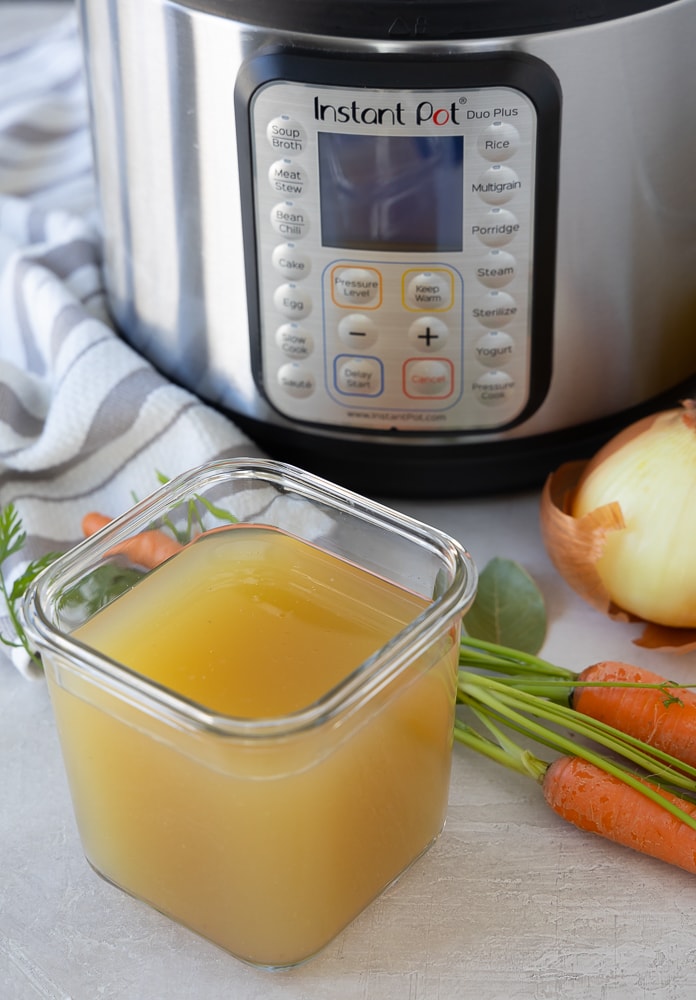
I started pressure cooking homemade chicken broth out of necessity, but now it's my go-to because the results are incredible. The Instant Pot extracts deep flavor and rich nutrients quickly, without the long simmer or tending traditional chicken broth requires. It's hands-off, fuss-free, and produces a clean, golden broth every time.
Jump to:
- Why You'll Love Instant Pot Chicken Broth
- Ingredients You'll Need
- Substitution and Variations
- How to Make Chicken Broth in an Instant Pot
- Straining and Chilling the Broth
- Refrigerate Broth Overnight
- How to Freeze Chicken Broth
- Pressure Cooker vs Slow Cooker
- Recipe FAQs
- More Broth and Soup Recipes
- ⭐️Did You Make This Recipe?
- 📖 Recipe
- 💬 Comments
Why You'll Love Instant Pot Chicken Broth
- Faster than traditional broth - Ready in a few hours instead of simmering for hours.
- Rich flavor from pressure cooking - Deep, golden broth with concentrated taste.
- Versatile use - Perfect for sipping or adding to recipes that call for chicken broth.
- Lower histamine option - Shorter cooking time makes it gentler for sensitive eaters.
- Better than store-bought - You control the ingredients, superior taste and nutrition.
Ingredients You'll Need
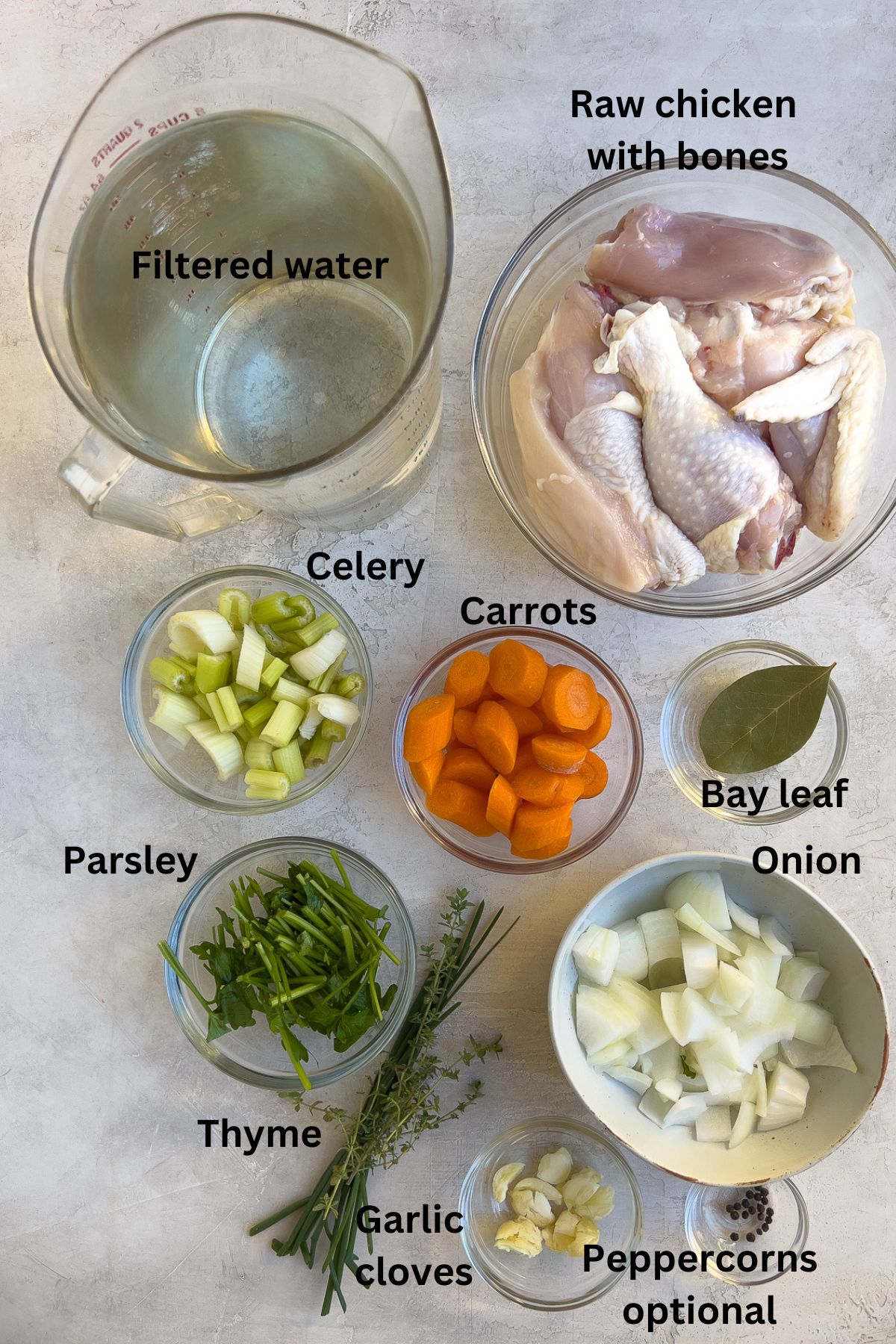
- Chicken - Use meaty, bone-in pieces such as whole legs and thighs. A whole chicken works too. Broth needs bones for body and flavor. Ask the butcher to cut it up, buy a pre-cut bird, or cut it yourself (a great skill to learn!). Whenever possible, choose organic.
- Onion - White, yellow, brown, or sweet onions all work for building a savory base.
- Carrot - Part of the classic French flavor base mirepoix (onion, carrot, celery). Adds natural sweetness and depth.
- Celery - Balances flavors and adds subtle herbal notes.
- Leek (optional) - Adds gentle, layered flavor if you have one on hand.
- Garlic - Boosts flavor and supports the immune system.
- Herbs - Fresh thyme, parsley, and a bay leaf (fresh or dried). Optional chives if you've got them.
- Filtered water - Always use clean, filtered water for the best-tasting broth.
- Black peppercorns - Add for mild spice and depth, but skip if you're histamine-sensitive.
Please see the recipe card for measurements.
Chef's Tip: NO SALT. You should never salt broth. Save the salt for the finished dish. It is more controllable that way and people have differing levels of salt sensitivity or the need for a lower sodium diet.
Substitution and Variations
- Garlic - Skip it entirely if you're allergic or sensitive.
- Leek - Use the dark green tops for broth; save the light white part for sautés and other cooking.
- Thyme - Fresh sprigs give the best flavor, but dried thyme works if that's all you have.
- Extra richness - Add a few chicken feet for a more gelatinous, collagen-rich broth. (It may feel unusual, but it's a classic chef's trick worth trying).
Chef's Note: is it stock or broth? Today the terms are used interchangeably, but technically stock is made from the bones of the chicken and broth is made from meaty pieces and vegetables. Bones make homemade chicken broth gelatinous (like jello) because bones release collagen as they cook.
How to Make Chicken Broth in an Instant Pot
If you're cutting up a whole chicken start at step 1. If you have pre-cut up chicken, start at step "broth instructions". You need a heavy chef's knife. Special heavy scissors called poultry shears are also very helpful, and not expensive to buy.
How to Cut Up a Whole Chicken
Place the chicken rounded side (top) up on a stable cutting board.
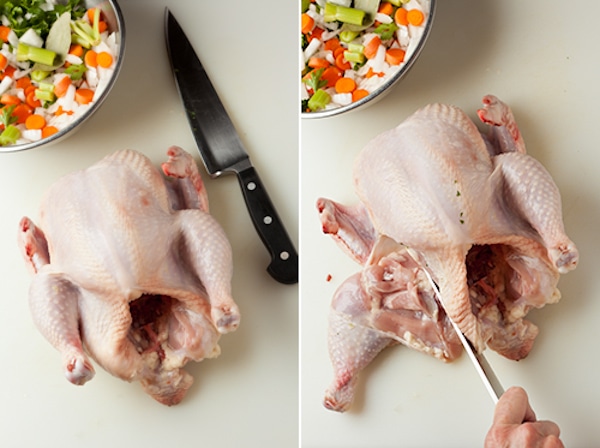
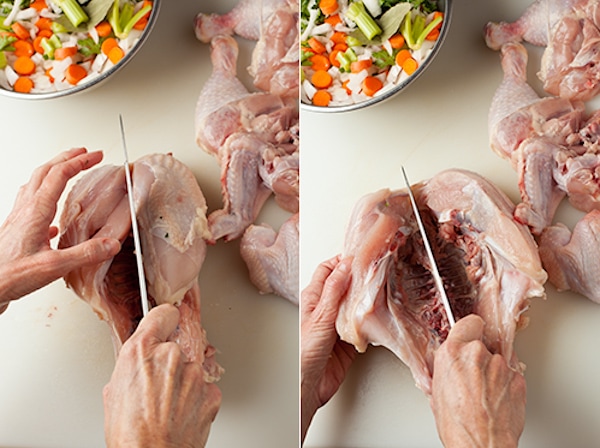
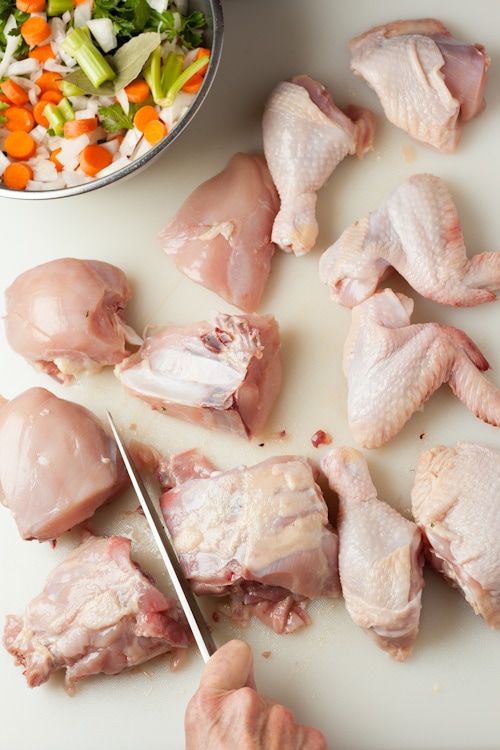
Broth Instructions
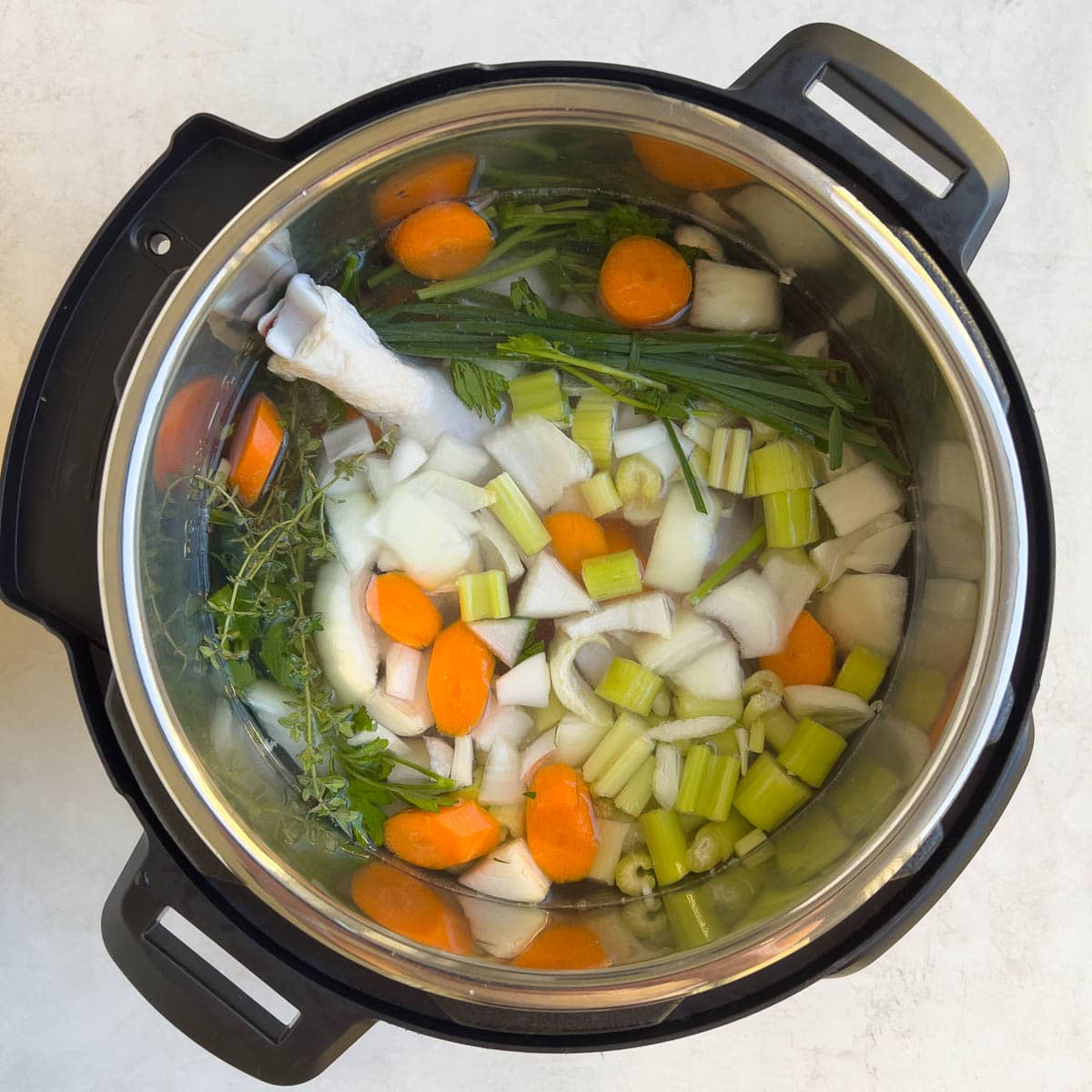
Add all of the ingredients to the pot then add the water. Don't fill the inner pot beyond the PC max fill line marked on the inside. Lock on the lid and turn the vent to lock. Press the Soup/Broth button and set the timer for 2 hours. It should be set to high pressure.
When the time is up, hit the cancel button and allow the pressure to release naturally for 20-30 minutes. After that, turn the vent button and let any remaining pressure release. Overall time with the pressure build and then the release is 3 hours in total.
Straining and Chilling the Broth

Strain the broth of spent chicken, bones and vegetables through a sieve or fine colander. Clean out the pot and add the broth back in, then place it in a sink full of ice and water to quickly chill (ice bath). Stir occasionally to assist the release of heat. After an hour (or less) your broth should be cold.
For refrigerator safety. let the chicken broth cool to 70°F before putting it in the refrigerator to further chill.
Chef's note: When I make long-simmered bone broth, I use a little apple cider vinegar to help release the collagen from the bones. For a pressure cooker vinegar is not needed as the higher temperature in pressure cookers converts collagen to gelatin quickly for nice rich broth. Added a few chicken feet insures the gelatinous texture.
Refrigerate Broth Overnight
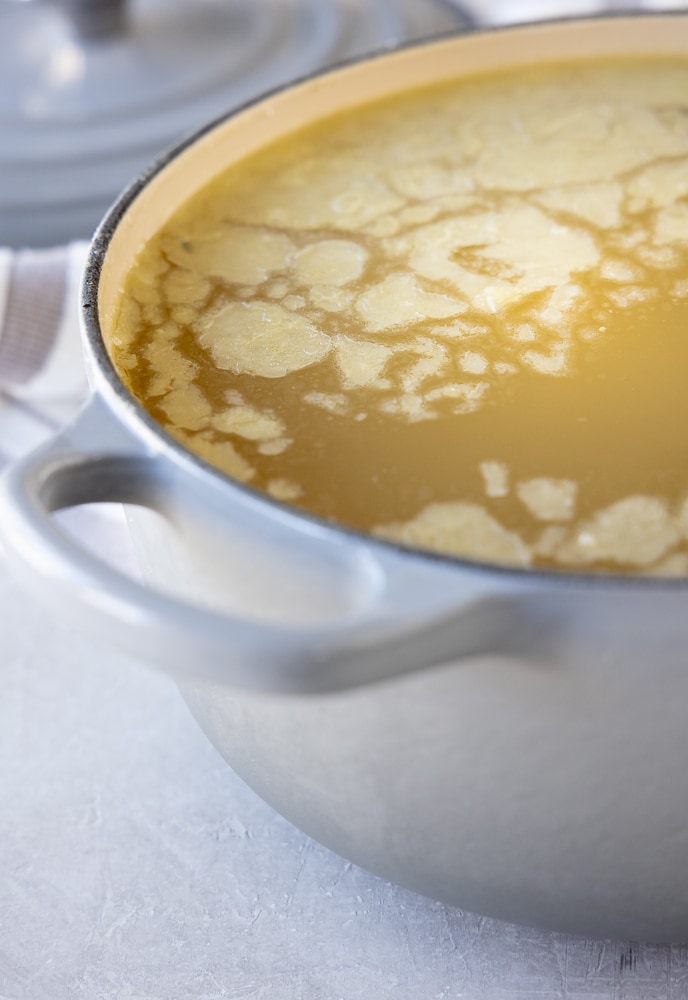
Cover the pot and place it in the refrigerator overnight. In the morning skim the solidified fat from the surface, portion, label and freeze.
One additional tip, sometimes I strain the broth one more time through a fine sieve (or cheesecloth) to remove any vegetable bits, but this is optional. You can use a small, mini fine strainer and do it as you portion into your containers for freezing.
How to Freeze Chicken Broth
I freeze in 1-cup and 3-cup portions for sipping and soups, or in mini portions (½ cup size) for deglazing pans to make quick sauces. Use mason jars, a freezer bag or other airtight container.
If using a freezer bags, be sure the broth is totally chilled, seal the bags well and lay them flat in your freezer on a small rimmed sheet pan to freeze solid. Then you can remove the sheet pan.
The reason this is not my favorite freezing method is the bags can get nicked and leak, plus it's plastic. Use glass or try these large silicone molds called Souper Cubes. Love them! Be sure to label and date your containers.
Pressure Cooker vs Slow Cooker
For homemade chicken broth, I recommend a pressure cooker (like the Instant Pot) over a slow cooker. Pressure cooking happens in a sealed chamber with steam and pressure, which extracts maximum flavor and nutrients from the chicken and vegetables in a fraction of the time.
Slow cooker - While convenient, most models only make smaller batches, and the flavor isn't quite as concentrated. I prefer making larger amounts in the Instant Pot so I can freeze the extra.
Instant Pot or electric pressure cooker - I use a 6-quart Instant Pot Duo Plus. Any brand works, and if you have a larger pot, scale up ingredients to make a bigger batch (cooking time may increase slightly).
Stovetop pressure cooker - Works just as well if that's what you have.
Four Ways to Thaw and Reheat Broth
- Refrigerator overnight - Transfer frozen broth to the fridge and let it thaw slowly. Reheat gently in a small saucepan over low heat.
- Microwave + stovetop - Loosen the broth in the microwave, then finish thawing and heating in a pan on the stove.
- Cold water bath - Place the frozen container in a larger bowl of cold water, changing the water every 30 minutes until thawed enough to transfer to a pan.
- Silicone cube method - If frozen in cubes, pop one out and melt it directly in a saucepan over low heat, covered.
Tip: if you use a freezer bag, be sure to place the bag in a large bowl to in case the bag has a hole and leaks.
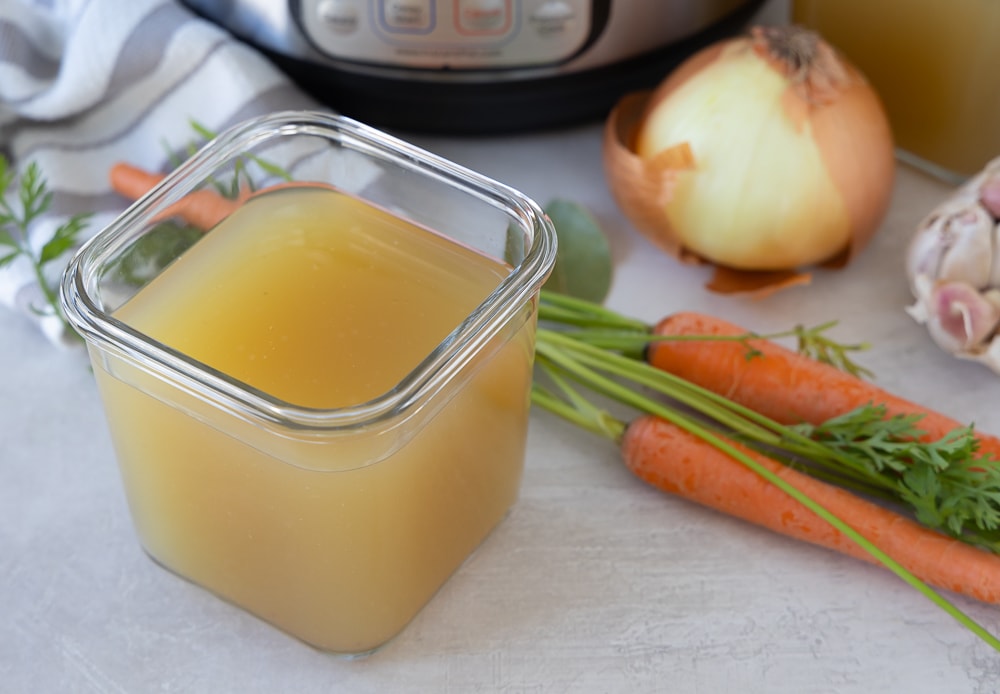
Recipe FAQs
When making chicken broth in an Instant Pot, it takes approximately 3 hours in total. It takes about 30 minutes to come up to pressure, then 2 hours to cook, then approximately 30 minutes for the pressure to drop before straining and chilling. Can I make a quick chicken broth for a shorter cooking time? Yes, I've made it with a cook time of 90 minutes versus 2 hours still with good results.
Use the high pressure setting on an Instant pot when making chicken broth.
Instant Pot chicken broth lasts 3-4 days in the refrigerator or 2-3 months in the freezer in appropriate containers, labeled and dated.
More Broth and Soup Recipes
For more broth recipes, try my long-simmered chicken bone broth, roasted turkey broth, and quick vegetable broth. Find chicken soup recipes here.
⭐️Did You Make This Recipe?
If you make Instant Pot chicken broth, please add your comment. I appreciate your feedback and enjoy hearing from you. If you loved it, please give it a 5-star rating! They really help other readers.
📖 Recipe
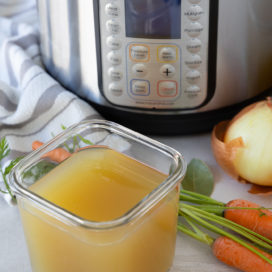
Easy Instant Pot Chicken Broth
Equipment
- 6 quart or larger Instant Pot or electric pressure cooker
Ingredients
- 4 pounds bone-in skinless chicken thighs and legs skinned as much as possible, see note below
- ½ onion chopped
- 2 carrots chopped
- 1 large rib celery chopped
- ½ medium leek, rinsed of sand chopped, optional
- 3 garlic cloves peeled and smashed
- 2-3 fresh thyme springs
- 1 bay leaf
- 2 quarts filtered water 8 cups
Instructions
Prep the chicken
- If using a whole chicken cut it into pieces and remove extra fat and as much skin as possible. For help see the photos in the post. If using pieces, also trim off extra fat and skin. Place the chicken in the pot, then add the onions, carrot, celery, leek, garlic, thyme, bay leaf and water.
Pressure cook
- Fill the pot up to the line that reads "PC max ⅔" with fresh filtered water, about 2 quarts. Lock on the lid and turn the vent to lock. Press the Soup/Broth button and set the timer for 2 hours. After 2 hours press the cancel button and allow the pressure to release naturally for 20-30 minutes. After that turn the vent button and let any additional pressure release.
Strain broth
- Strain the spent chicken, bones and vegetables thorugh a sieve or fine colander into another container. Wash the pot, then add the broth back to the pot for chilling.
Chill broth
- Fill a sink half full of ice and cold water for an ice bath. Place the pot in the ice bath and chill for about 1 hour, or until the broth is below 70°F. Cover and place the pot in the refrigerator overnight. In the morning, skim the surface of solidified fat, then portion, label, and freeze.
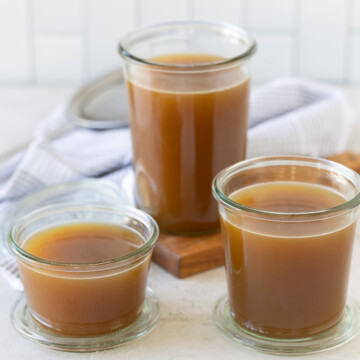
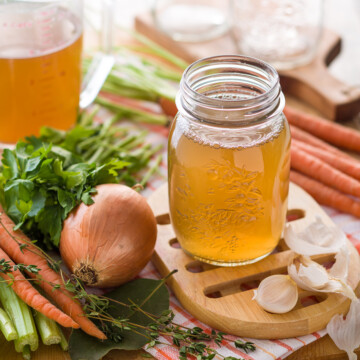
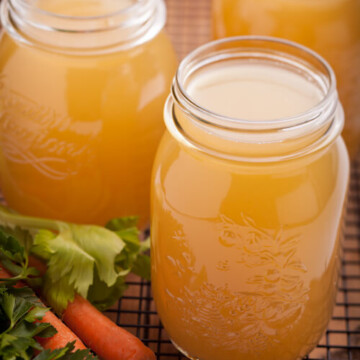
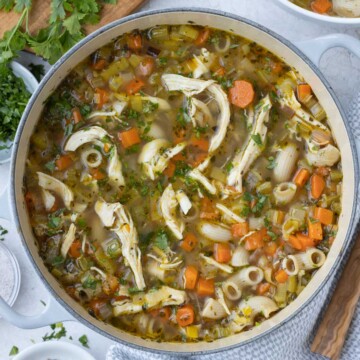
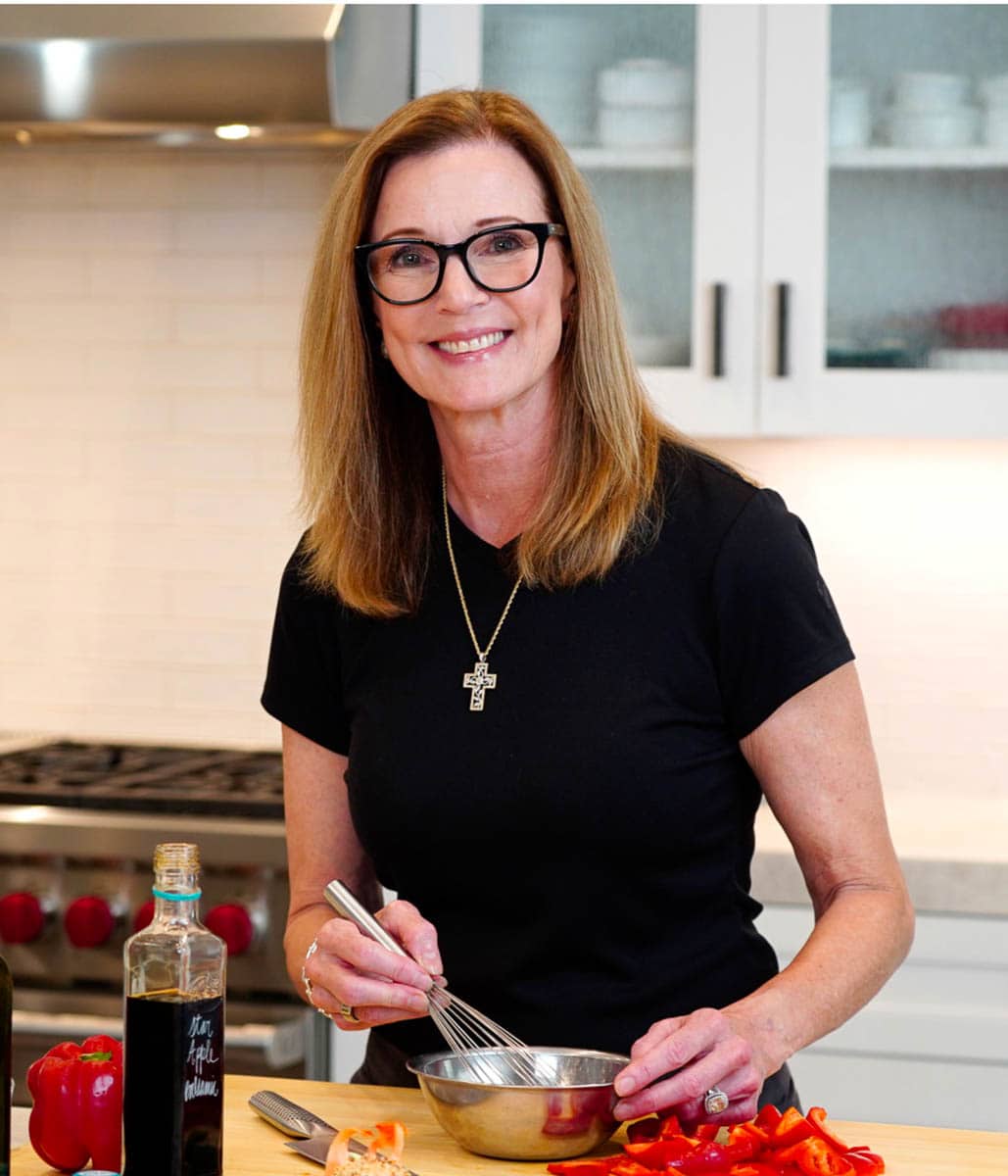
Laura says
Hi! If I want to save the fat, what is the best way to save it?
Sally Cameron says
Hi Laura, here's how to save chicken fat (also called schmaltz) . After chilling the broth, the fat will solidify on the surface. Carefully lift or scrape off the solidified fat with a spoon or spatula. Melt the solid fat gently over low heat in a small saucepan.
Pour the melted fat through a fine-mesh strainer into a clean jar with a lid to remove any impurities or bits of herbs and vegetables. Label the container with the date for reference. Chicken fat will last about 1 week in the refrigerator or up to 3 months in the freezer.
For freezing, try using ice cube trays, especially the silicone ones with lids. One more tip, if you really want to save and use the fat, don't remove skin from the chicken before cooking. The only thing is you'll have a little less broth because of the extra skin. Let me know if that helps.
Debra Rowe says
Hi Sally: I did not realize a pressure cooker would cook for 2 hours. Amazing. I will give this a try. I know there are tons of differing opinions (rather than anything even remotely fool proof), but my nutritionist who helps me fight thyroid has advised I keep the fat in my meat stock and has said that pressure cooking denatures the food. Your stock looks richly golden, and I wonder what your findings have been to remove the fat? I had heard it was especially good to have for digestion tract repair for leaky gut. Thanks!
Sally Cameron says
Hi Debra, good question! Yes, they can go that long. I've also tried it for just 90 minutes with great results, in fact I may amend the recipe after more testing. Pressure cooking is healthy as it keeps the nutrition in. I am hypo-thyroid (as well). I always de-fat or de-grease my broths and stocks and add the fat I want back into the dish I am preparing. Leaky gut is a "fun" one (not really, I know). Ever read Eat Dirt by Dr. Josh Axe? Highly recommend for leaky gut. So far science say that pressure cooking is safe, and no research exists to the contrary. The science is not conclusive. The other thing is about using the IP for broth is that because of the short time frame of cooking versus bone broth, it's better for people with Histamine Intolerance (like me). Additionally, think about cooking chicken breasts in the oven. I cook mine at 375°F, and I grill them at 400°F. Pressure cooking reaches about 240° inside that sealed chamber. Here is a good article https://www.cnet.com/health/nutrition/is-your-instant-pot-destroying-nutrients. There are interesting posts out there on the subject.
Cheryl says
If you free a carcass or chicken how do you defrost it to use without increasing histamine? Thank you
Sally Cameron says
Hi Cheryl. If after roasting a chicken and stripping any extra meat you freeze the body right away, you can probably use them frozen but it will take longer. I've not tried it. Set the time for two hours and go through the release, then open and test it. I sometimes do that with my traditional broth recipe. You can also make that one, just don't let it go a long time. Stay with the 2-3 hour mark to keep histamines low. I hope that makes sense. One thing that will help; don't throw the whole carcass into plastic zip bags to freeze. Break them down into smaller pieces with a heavy knife or poultry/kitchen scissors so the pieces are small. They will thaw faster.
Kelly S says
If I make a whole chicken from frozen in my instant pot, can I toss in the veggies with it as above, and then use the broth afterwards? If so, would I just cook it on high for 2 hrs instead of on soup/broth? Thanks!
Sally Cameron says
Hi Kelly. First I would thaw the chicken (not use frozen). You may know that but I am not sure by your question and don't know how experienced a cook you are. Is your desire to make chicken soup or make broth? When you make broth this way, the chicken and vegetables are pretty well spent after two hours under pressure. It all falls apart and has given up its goodness to the broth. Then you strain off the broth, chill, and refrigerate so when it cools completely you can scoop the extra fat off the surface. If your desire is chicken soup, I would make the broth first, then make soup with the broth. Others may do it different but I think this gives the best results. If you make batches of broth and freeze you are always a short time away from having great soup. For even richer deeper broth, try the long version bone broth (not Instant Pot). It takes longer but much of the work is hands off. https://afoodcentriclife.com/liquid-gold-homemade-chicken-broth/ . I hope this answers your question if not let me know.
.
Kristina Pruett says
Can the chicken meat be used?
Sally Cameron says
Hi Kristina. The meat is pretty spent after giving it's all to the broth. I have a friend who used to save it for her dogs, but not for her consumption. If you use leftover frozen carcasses from roasting whole birds and even add about a half pound of chicken feet you won't have much meat anyway. I did the my last batch that way, now in the freezer. I use about 3-4 roasted carcasses and a few feet and the broth came out great, very gelatinous (collagen). One tip on saving your roasted carcasses. Before freezing, break the body down into smaller pieces with a heavy knife or poultry shears. That way they take up less room. Make sense? Thanks for asking, great question.
michael says
always follow you and your healthy cooking Thank you for sharing with me
Sally Cameron says
Thank you Michael for following, reading and commenting. It means a lot.